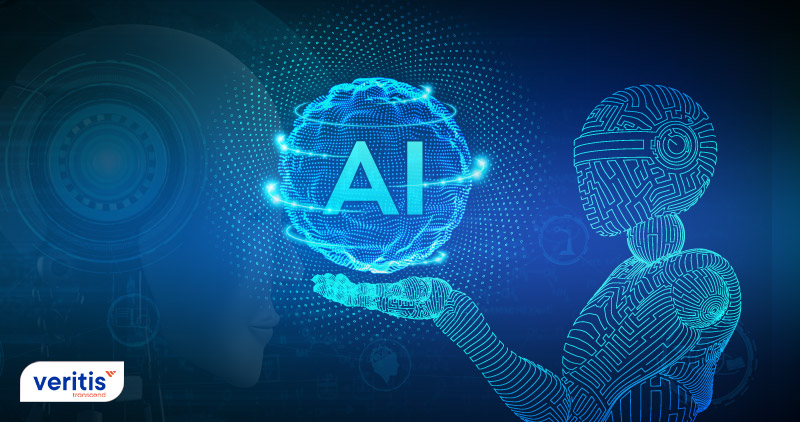
You’ve undoubtedly heard or read about the ubiquitous buzzword known as artificial intelligence or AI. When you think about AI, articles about technology, the digital age, and robotics might come to mind. But what is it, and how does one use it? Programming technology to solve problems is an improvement in artificial intelligence. Big data, machine learning, and deep learning are topics that are frequently brought up while discussing artificial intelligence.
With the aid of artificial intelligence (AI), machines may mimic human behavior, learn from their mistakes, and adapt to new inputs. Deep learning and natural language processing are prominently utilized in most AI instances you hear about in today’s era, including self-driving vehicles and chess-playing computers. Computers may train to perform jobs using these technologies by processing vast volumes of data and identifying patterns in the data.
Making decisions continues to be the ultimate leadership test for aspiring business entrepreneurs. Even seasoned executives with a history of wise choices have occasionally done something disastrous that damaged their reputations. Yet, making wise decisions is one of a leader’s essential competencies in the world. Leaders may use data and analytics to support their decision-making under the aegis of AI, unlocking its ability to make creative and strategic decisions.
Leaders are particularly interested to learn if AI implementation will make their jobs more accessible as it is predicted that it will revolutionize the organization significantly. While most are enthusiastic, some do not want to make more complex decisions. The cornerstone of their reputation as good leaders is their capacity to make wise decisions without using sophisticated technologies.
Modern business leaders must cope with numerous moving components daily, including remote employment and emerging technologies. Business owners don’t typically have the time to spend hours upon hours trying to evaluate each row, column, or cell of data to conclude. Business leaders can now tackle two issues at once thanks to AI decision-making. Massive datasets may evaluate immediately, and cognitive biases can be eliminated from the procedure so that only objective, fact-based information is used to make decisions.
The good news is that since decision-makers need to add discretion to the machine projections, AI is highly unlikely to make their jobs easier. Nevertheless, there are some ways in which business decision-making will unavoidably be impacted by the primary goal of AI, while the precise impact is still unknown. AI implementation can change how executives make decision-making.
Useful link: What is Edge Machine Learning?
What is Artificial Intelligence?
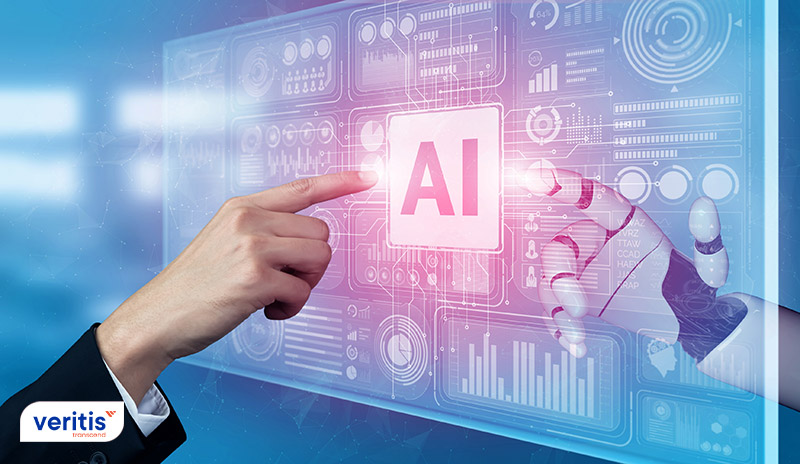
Artificial intelligence is a technology that enables robots and software to replicate human intellect by learning from experience through iterative processing and algorithmic training. Visual perception, speech recognition, decision-making, and word translation are all tasks that typically require human intelligence. But today, computer programs can employ their intelligence and skill to accomplish these issues.
When a group of mathematicians and scientists gathered in June 1965 at Dartmouth to debate the possibility of creating a computer that could genuinely think, this sort of intelligence was born. Although they had no idea what it would be called or how it would operate, their conversations there lit the fuse that launched artificial intelligence. The evolution of this intellect has had highs and lows since the “Dartmouth workshop,” as it is known. Years passed, during which the notion of creating an intelligent computer was dropped and little to no effort was made to this form of intelligence. And a frenzy of effort has been made in recent years to create and incorporate this fascinating, intelligent technology into daily life.
You can think of Introduction to AI as a type of intelligence used to address issues, find answers, provide information, predict the future, or make tactical recommendations. AI has become quite significant to contemporary corporations and other sorts of organizations because it can accomplish these things.
The field of artificial intelligence has grown over time because of technological developments. The three recognized types of AI spectrum can encounter today are:
1) Automation Intelligence
To put it simply, it entails completely automating the process while cutting out humans. For instance, self-driving cars and autonomous robots.
2) Assisted Intelligence
It concentrates on automating simple chores and taking machines from assembly lines as an example.
3) Augmented Intelligence
Symmetry is a byproduct of enhanced intelligence. The procedure is reciprocal. To learn from human input, machines are to be used. Humans, meanwhile, rely on insightful data to make accurate decisions.
Useful link: AI-Powered, ML-Driven – The New DevOps Trend!
Recognize When to Use AI for Decision-Making
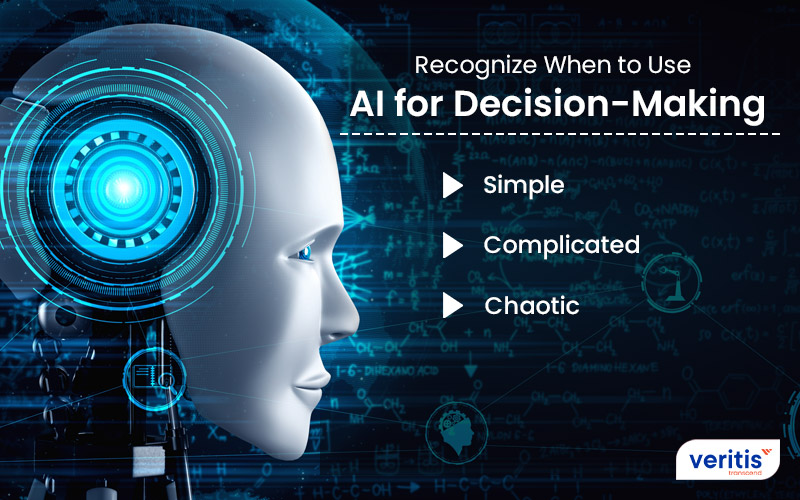
The ability or necessity of AI applications to automate, augment, or support a choice depends on two essential factors: complexity and time or how quickly the business needs a conclusion.
The time dimension describes the interval between the organization’s initial awareness of risk or opportunity and its actual decision-making and action-taking. For instance, the time frame for high-frequency stock trading may just be a few microseconds; for pay decisions, it might take weeks; for strategic mergers and acquisitions, it can take months or even years.
The so-called Cynefin framework, for instance, depicts the continuum of complexity as ranging from simple through complicated, complex, and chaotic.
1) Simple
Simple situations are steady, predictable, and have a clear cause-and-effect relationship. Payroll processing and contact center routing are two examples of artificial intelligence.
2) Complicated
Complicated situations need knowledge or analysis to determine causes and effects, frequently employing knowledge of a tried-and-true problem-solving method. Instances include asset management, insurance fraud, and conducting marketing promotions.
Complex situations often entail a variety of relationships and dependencies. Thus, the practical analysis calls for a systemic or holistic approach and simulations to show how choices could impact distant elements. A few examples of artificial intelligence include supply chain disruptions.
3) Chaotic
Unknown causes and consequences lead to uncertain or dynamic interdependencies in chaotic environments. Minor adjustments could have disproportionately large effects. Making decisions is highly challenging and necessitates trial-and-error learning. Instances include battlefields, natural calamities, and financial market crises.
Useful link: All You Need to Know about Artificial Intelligence as a Service (AIaaS)
Artificial Intelligence Decision-Making at Multiple Levels
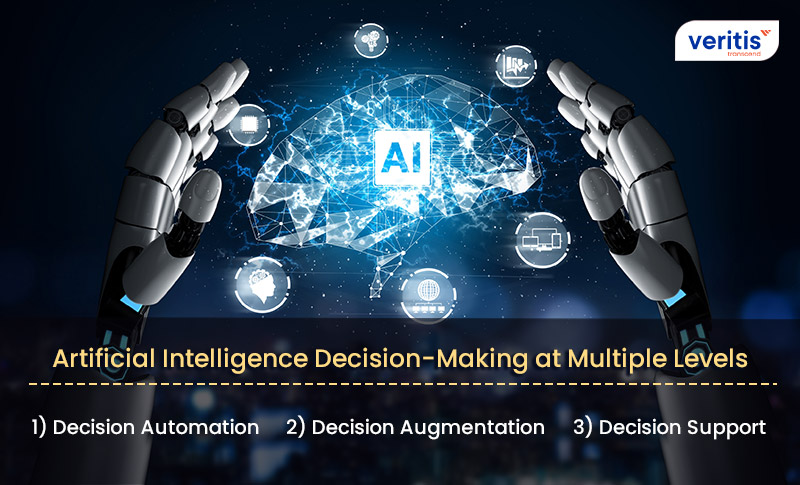
Humans may not always make the best decisions or do so consistently, yet they nonetheless possess valuable skills. Similarly, the main goal of AI has a position in decision-making. The degrees to which artificial intelligence and analytics applications can use to pursue quicker, more reliable, more flexible and higher-quality judgments at scale are represented by decision automation, decision augmentation, and decision support.
The decisions made at multiple stages of the decision-making process fluctuate depending on who decides in the end. The decisions made at numerous stages of the decision-making process differ depending on who makes them in the end, as well as the analytics techniques employed at those stages:
1) Decision Automation
Using predictive or prescriptive analytics, the system decides. Its benefits include decision-making that is quick, scalable, and consistent.
2) Decision Augmentation
Using prescriptive or predictive analytics, the system suggests a decision or many decision options to human actors. Its advantages lie in the synergy between human expertise and AI’s ability to evaluate large amounts of data and deal with complexity quickly.
3) Decision Support
Descriptive, diagnostic, or predictive analytics support the decision-making of human employees. Using human knowledge, skill, and common sense, including “gut feel” and emotions, along with data-driven insights and insights from other sources, is where it derives most of its advantages.
AI’s Ability to Make Decisions Rely on Complexity and Time
Leaders can evaluate individual decisions and decide whether it would be worthwhile to automate, enhance, or support them by combining the variables of time and complexity.
Automation is a desirable alternative for quick decisions that must be made in seconds to 15 minutes. For complex judgments or ones that must be made in a matter of minutes or hours, decision augmentation is a possibility. Leaders can investigate decision support for complex, even chaotic, and non-urgent decisions.
In every one of these cases, the top AI solution provider is applicable. Leaders should anticipate that the boundaries of what may be feasibly automated will progress along the axis of complexity over time as technology develops.
Useful link: 10 Ways Artificial intelligence (AI) is Transforming DevOps
Top 10 aspects of how AI works and how applications of artificial intelligence can help leaders improve their decision-making abilities:
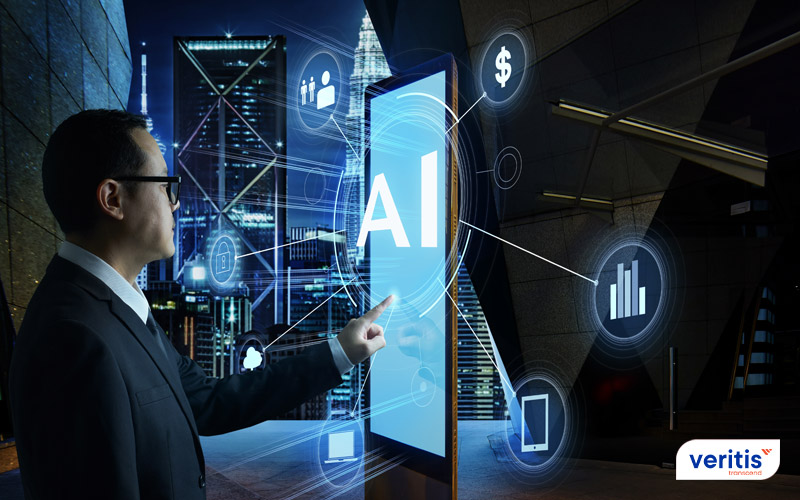
1) Leaders Can Identify Opportunities and Risks
Leaders must be aware of opportunities and risks to make the best decisions. AI can do this by analyzing data and identifying patterns that can be used to find the chances and threats. For instance, you might use the most advanced AI to keep an eye on rival activity so that you can see what new products they were introducing, what discounts they were running, and how their prices compared to yours. Your ability to modify your methods considering this would be provided.
2) Prediction
Many companies are already employing predictive analytics to improve decision-making through data mining. With the help of predictive analytics, organizations can foresee occurrences by analyzing a data set and making an educated prediction of what will occur in a specific future period.
Machine learning, another method used in predictive analytics, is a top AI solution provider component. The difference is that data mining only entails finding patterns in massive data sets. At the same time, machine learning involves creating machines that can learn from the data and act on it on their own.
Using the data presented, decisions can be taken regarding things like:
- Based on cost-effectiveness and possible ROI, certain advertisements are displayed.
- How to improve the buying process by examining consumer behavior.
- How to lower churn among customers.
3) Fewer Decisions to Make
Numerous psychological studies have demonstrated that we must make many decisions quickly. Our quality suffers because our mental energy progressively becomes depleted.
Placing candies and snacks at the pay register at supermarkets is an example of artificial intelligence of how this might be used. Marketers know that you will make decisions throughout your little shopping trip and that by the time you’re finished. You won’t be able to resist the sugar rush as well.
Algorithms can make an endless number of daily decisions, each as precise as possible because they are not susceptible to decision fatigue. As a result, executives who employ the most advanced AI will have an advantage since they can surpass human weaknesses.
4) Multi-Tasking
Executives often need to consider a variety of multiple considerations while making complex decisions. When there is too much information to evaluate, the decision-maker may become overwhelmed and make unwise choices.
On the other hand, a machine can manage several inputs without being overwhelmed or confused. All required is a collection of instructions or programs that direct the machine to use probability and recommend or carry out the most logical conclusion.
5) Enhanced Human Judgement
The decision-maker will always be a human until we can give AI emotional intelligence. Uncomplicated jobs that don’t require emotional intelligence and experience—the two elements that serve as the foundation of judgment in business—can be handed to a machine. However, a human is required for the more important ones with a higher chance of error and a higher financial penalty. Another crucial component of sound judgment that cannot be left to top AI solution providers, according to Ajay A., Joshua G., and Avi G., is the capacity to make trade-offs when appropriate. This is so that one may make an informed decision. This includes having a thorough awareness of the organization’s values, goals, and risks.
However, using AI operations in decision-making is still possible and desirable. Its function is to inform humans of all the information and scenarios that might occur.
6) AI Guides Leaders in Better Communication
In any organization, effective communication is essential to its success. After all, it’s the primary means by which leaders express their vision and guide their team. Leaders can pinpoint crucial issues with their team members and produce quick solutions using the most advanced AI. Leaders can also keep an eye on sentiment in communication channels to spot possible areas for improvement.
7) AI Can Detect the Root Cause of Issues
Leaders must find the root of the issue to solve it effectively. They may now use AI to comprehend their company’s data far deeper. By identifying artificial intelligence trends and patterns, AI provides them with real-time insights and feedback, ultimately assisting them in finding the underlying causes of issues and proposing solutions.
8) AI Can Reduce Workload by Time Taking or Automating Repetitive Tasks
Your daily activities involve different repetitive and time-consuming chores, even if you aren’t aware of them. Artificial intelligence (AI) can automate monotonous jobs so you may concentrate on more important things. A leader can use AI operations to automate reviewing and approving expense reports, for instance, if they need to examine numerous of them.
9) Leaders Can Make Decisions in Difficult or Ambiguous Circumstances
Leaders frequently must make judgments without complete access to the facts. AI operations can help them by presenting potential scenarios and results based on historical data and recent artificial intelligence trends. While they don’t have all the answers, it guides leaders to make more informed business judgments.
10) AI Assists Executives in Staying Current with Emerging Trends and Technologies
What was effective yesterday might not be effective today since the world is constantly changing. To stay current with trends and advancements, AI operations may help leaders in various ways. For instance, AI can keep an eye out for pertinent terms and phrases on social media and other online platforms, allowing leaders to spot emerging artificial intelligence trends early on, make decisions that are in keeping with the times, and stay one step ahead of the competition.
Conclusion
The future holds a lot of intriguing changes. Although AI might not always simplify the process, it will significantly help streamline decisions for better procedures and a more flexible business in the future.
Vendors of businesses currently face only one risk: failing to utilize AI technology. However, as more companies incorporate AI into their IT stacks, they become more competitive in terms of how focused their marketing is, how correctly they can predict future demand, and how rapidly they can pivot when issues develop.
Veritis, the Stevie Award winner, is the preferred choice for artificial intelligence outsourcing requirements. We have offered services and solutions to Fortune 500 and emerging organizations. So, reach out to us to receive the customizable solution that fits your business.
Got Questions? Schedule A Call
Additional Resources:
- How AI Adoption Will Transform Your Business
- All You Need to Know about Artificial Intelligence as a Service (AIaaS)
- 10 Ways Artificial intelligence (AI) is Transforming DevOps
- Application Container Market to Reach USD 8.2 Bn by 2025!
- AI-Powered, ML-Driven – The New DevOps Trend!
- Why Data Driven Culture is Important for You